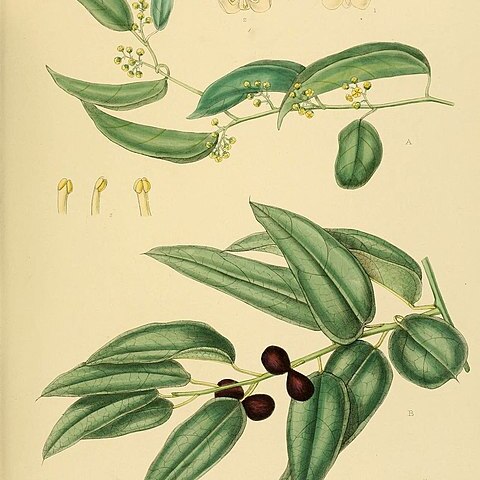Woody climbers, without prickles. Leaves mostly ovate to elliptic, with 1–3 pairs of basal veins which do not extend to leaf margin. Inflorescences axillary or terminal, thyrsoid, or apparently paniculate or racemose (in Australia), without accrescent bracts. Male flowers: sepals 6–12, spirally arranged, imbricate, usually glabrous, outer ones minute and bracteole-like, inner ones larger; petals 3–9, fleshy, glabrous; stamens 7 – c. 40, free or connate. Female flowers: sepals and petals similar to male; staminodes absent (in Australia); carpels 2 or 3; stigma reflexed, entire, sometimes convoluted. Drupes subcompressed-obovoid to subglobose, without stipe or carpophore; style-scar near base; endocarp bony, with 2 lateral hollow chambers, sometimes each with an external aperture, dorsally smooth to rugose. Seed horseshoe-shaped; embryo narrow, embedded in endosperm; cotyledons as long as or slightly shorter than radicle.
Scandent shrubs or woody climbers. Stems with young growing tips sometimes tendrilliform. Leaves ± ovate to elliptic, base 3-7-nerved with the side nerves sometimes supra-basal. Inflorescence axillary or supra-axillary, cymose or thyrsoid. Male flowers: sepals 7-12, spirally arranged, glabrous or subglabrous, outer ones minute and bracteoliform, inner ones larger, imbricate; petals 5-9, fleshy; stamens 9-40, free or connate. Female flowers: sepals and petals similar to male; staminodes 0-several; carpels 2-3, stigma entire, reflexed. Drupes curved, subcompressed-obovoid to-globose with style-scar near base; endocarp laterally convex with 2 lateral cavities each with an external aperture, dorsally rugose to rugulose. Seed horseshoe-shaped, narrow, embedded in endosperm.

